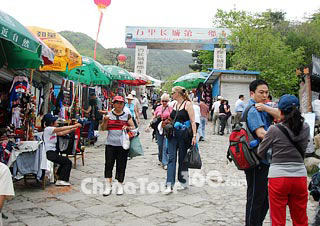 Mutianyu, Beijing
Mutianyu, Beijing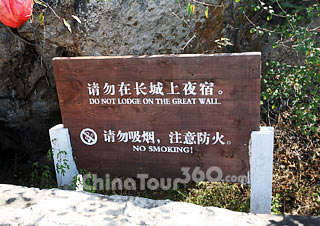 Simatai Travel Tips
Simatai Travel Tips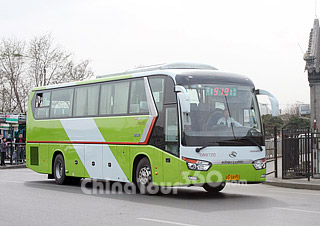 Bus No. 919, Badaling
Bus No. 919, Badaling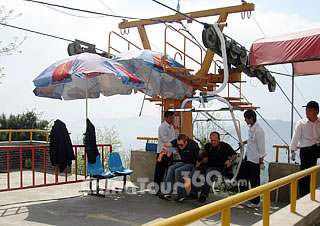 Cable Car, Mutianyu
Cable Car, Mutianyu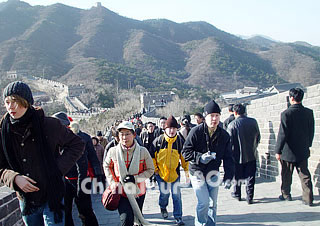 Badaling Tour
Badaling Tour
To prevent the people and territories from a continued threat by the northern nomadic tribes, the industrious and ingenious ancient Chinese built the ten-thousand-li (one li is half a kilometer) great wall across the deserts, grasslands and mountains in the northern border of China, making full use of the natural barriers.
Today, this huge historic heritage site attracts tens of thousands of visitors each year from all over the world.
Due to its remote location and poor condition, it is rather dangerous and difficult to walk along the wall unless you are well prepared. This Chinatour360 article provides travel tips to help you get the most from your adventure on the Great Wall.
![]() When to Visit
When to Visit
The Great Wall is a year-round attraction with timeless charm, presenting different beauty in each of the four seasons. The best weather is during spring and autumn particularly May, September and October. However, to enjoy the grand snow-capped wall, winter is the only choice, but do wear warm down coats, wool sweaters, long warm boots with projections on the soles, scarf and gloves. The sections on the high mountains or near to the sea, such as Badaling, Mutianyu and Shanhaiguan, are also ideal summer resorts.
![]() Which Section to Visit
Which Section to Visit
Unfortunately, a large part of the wall, which spreads for about 8,851.8 kilometers (5,500 miles), has been destroyed by natural factors and human activities. In recent years, through tourism development, some sections built in the Ming Dynasty (1368 - 1644), Such as Badaling, Mutianyu, Simatai, Shanhaiguan and Juyongguan, have been renovated to varying degrees. However, those early earth-rammed sections in Gansu, Ningxia, Shaanxi and Shanxi are in ruins or non-existent. Thus, tourists are advised to visit those open sections with well-developed transportation and other supporting facilities.
Badaling is the first choice for many travelers, since it is the best-preserved section and most representative of the Ming Dynasty. It is also the first section to open with convenient transportation and complete supporting facilities. Mutianyu is well-known both for its magnificent autumn beauty and 'No. 1 Cable Car of the Great Wall'. Juyongguan, the closest section to Beijing, is famous for its large amount of stone inscriptions. Shanhaiguan is favored by travelers for its proximity to the Bohai Sea.
![]() How to Prepare
How to Prepare
![]() Reading: Read about the history of the wall in advance. The more you know about it, the more deeply you will be impressed when you see it.
Reading: Read about the history of the wall in advance. The more you know about it, the more deeply you will be impressed when you see it.
![]() Physical & Psychological Preparation: Most of the walls were built on the lofty mountains, so it's a test of human endurance and the power of mind over body. For those who do not exercise regularly, it's advised to do some physical training 3-4 weeks in advance to avoid back, leg and feet pain after walking.
Physical & Psychological Preparation: Most of the walls were built on the lofty mountains, so it's a test of human endurance and the power of mind over body. For those who do not exercise regularly, it's advised to do some physical training 3-4 weeks in advance to avoid back, leg and feet pain after walking.
![]() Clothing: It is often windy on the Great Wall and there is usually a large temperature difference between daytime and nighttime, so it is always necessary to take a spare overcoat even in the hot summer days. In early spring and late autumn, a thick wind jacket is highly recommended.
Clothing: It is often windy on the Great Wall and there is usually a large temperature difference between daytime and nighttime, so it is always necessary to take a spare overcoat even in the hot summer days. In early spring and late autumn, a thick wind jacket is highly recommended.
![]() Shoes: Before the trip, remember to choose a pair of comfortable and light shoes. Sports shoes with projections on the soles are best. Avoid wearing high-heeled or thin-and-hard-soled shoes, since they will make you fatigueg, destroy your feet or even put you in danger.
Shoes: Before the trip, remember to choose a pair of comfortable and light shoes. Sports shoes with projections on the soles are best. Avoid wearing high-heeled or thin-and-hard-soled shoes, since they will make you fatigueg, destroy your feet or even put you in danger.
![]() Food & Drink: Climbing up the wall takes a lot of physical energy, so prepare enough drinking water and food in advance. However, be careful to not drink too much water at once, since this may cause abdominal pain or discomfort. Also, be sure take along fresh fruits.
Food & Drink: Climbing up the wall takes a lot of physical energy, so prepare enough drinking water and food in advance. However, be careful to not drink too much water at once, since this may cause abdominal pain or discomfort. Also, be sure take along fresh fruits.
![]() Sunburn Protection: There are no trees on the Great Wall, so it's advised to take an umbrella used as a protection from both the sudden rains and the strong ultraviolet radiation on the sunny summer day. If you are climbing the wall in summer, suntan lotion, hat and sunglasses are essential.
Sunburn Protection: There are no trees on the Great Wall, so it's advised to take an umbrella used as a protection from both the sudden rains and the strong ultraviolet radiation on the sunny summer day. If you are climbing the wall in summer, suntan lotion, hat and sunglasses are essential.
![]() Medicine: Due to its remote location, tourists should take some basic first-aid items and commonly used medicines with them. Suggested items are such as band-aids, bandages, cold medicine, stomachic tonic, motion sickness, insect repellant, balm as well as medicine to prevent heatstroke.
Medicine: Due to its remote location, tourists should take some basic first-aid items and commonly used medicines with them. Suggested items are such as band-aids, bandages, cold medicine, stomachic tonic, motion sickness, insect repellant, balm as well as medicine to prevent heatstroke.
![]() Alpenstock: Middle-aged and older adults can rent an alpenstock to help protect their knee joints from being hurt by the impact when climbing up and down the wall.
Alpenstock: Middle-aged and older adults can rent an alpenstock to help protect their knee joints from being hurt by the impact when climbing up and down the wall.
![]() Direction Instrument: Hikers to those underdeveloped sections, such as Jiankou and Xifengkou, should have a compass or GPS system, since there may be no distinctive signposts there.
Direction Instrument: Hikers to those underdeveloped sections, such as Jiankou and Xifengkou, should have a compass or GPS system, since there may be no distinctive signposts there.
![]() Communication Equipment: The mobile phone signal is poor in the underdeveloped sections, so it's better to hike with a group of 3-4 members and take walkie-talkies.
Communication Equipment: The mobile phone signal is poor in the underdeveloped sections, so it's better to hike with a group of 3-4 members and take walkie-talkies.
![]() Additional Information:
Additional Information:
A. Cable cars are only available in Badaling, Mutianyu, Simatai and Jinshanling.
B. For specific and detailed information about the admission fee, transporation, dining and accommodation of each section, please go to Great Wall Sections.
C. If feeling run-down, or if you experience excessive sweating, dizziness or heart thumping while climbing up the wall, please stop and rest.
D. Most of the paths on the wall are stone steps that are steep and abrupt along the mountain ridges, so bend forward when climbing up and balance the body's center well when climbing down. Stop and enjoy the sights, but kepp very focused on the path while you are walking.
E. When coming to the steep and dangerous parts, watch for cloth strips tied on the tree branches or arrows marked by other visitors. These usually indicate the safer pathways.
F. Be sure to rest often during the climbing. Tourists may feel hot and sweaty when climbing the wall, but be careful and guard against catching a cold by never sitting on the airway during a break.
G. Try to avoid climbing the wall in heavy rain, thunderstorm, snow or strong wind.
H. Please respect the local ethnic culture and customs. For instance, there is a Man Minority group around Mutianyuin the Huairou District, Beijing.
I. If you plan to hike in underdeveloped sections, it's better to go with a group. You should make a comprehensive plan in advance, including the route, transportation, distance to travel each day, daily destinations, dinning and accommodations.







